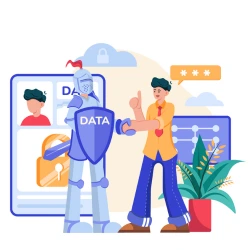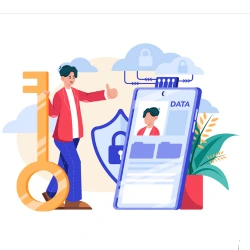TABLE OF CONTENTS
Data encryption is critical in a time when cybercrime threatens users sharing their information online. You can protect your business by ensuring safe online shopping for your customers. This doesn’t mean that brick-and-mortar stores have the upper hand; unprotected POS systems could also lead to data leaks. Nevertheless, as a merchant, you need to do everything in your power to keep your customer’s information secure. All you have to do is make sure your payment gateway is guarded by a process called data encryption. Continue reading to discover what data encryption means, the types, the pros & cons, and how to protect your data with it.
What Is Data Encryption?
Data encryption converts readable data into text that’s only readable to those who hold the so-called encryption key. The encrypted data (also called a ciphertext) is completely unreadable without the key. Data encryption itself doesn’t prevent data theft from happening. However, in case there is data theft, it prevents the person or entity with the information from reading it. In payment processing, data encryption protects your customers from credit card fraud.
How Does Data Encryption Work?
Data encryption works by securing transmitted digital data on the cloud, computer, and POS systems. Data encryption algorithms have replaced the old Data Encryption Standard to meet modern standards. In addition to securing data, these algorithms facilitate security initiatives such as integrity, authentication, and non-repudiation. They begin by verifying a message’s origin. Once the origin has been determined, the integrity of the contents is checked. As a final measure, the non-repudiation initiative prevents senders from denying legitimate activity.
This technology can be used for a wide range of data protection requirements including government-classified data and credit card transactions.
Types of Data Encryption
Besides knowing what encryption is, it’s important to distinguish between the two types. This will help you decide which encryption suits your needs best. Depending on whether it’s the same key for encryption and decryption, data encryption can be symmetric or asymmetric.

Asymmetric Encryption
Asymmetric encryption, also known as public-key cryptography, uses two interconnected keys — a public and a private key. Much as the name suggests, the public key is accessible by everyone and its purpose is to encrypt data. The private key, however, is only accessible to its owner and they can only use it to decrypt data encrypted with the public key.
Asymmetric encryption is better for payment processing, this is how it works. After customers enter their credit card information, it’s encrypted using the public key, and can only be decrypted using the payment gateway’s private key. Through this method, unauthorized parties can’t access customer data during transmission from the gateway to the acquiring bank.
The two most common asymmetric algorithms include:
- RSA Encryption — In 1977, Ron Rivest, Adi Shamir, and Leonard Adleman patented the RSA (an initialism of their last names) which has become the most widespread asymmetric algorithm. This algorithm multiplies two random prime numbers to create a new giant number. To solve it, one would have to find the original prime numbers based on the giant multiplication, which is practically impossible.
- ECC Encryption — Mathematicians Neal Koblitz and Victor S. Miller developed elliptic curves as a cryptographic algorithm in 1985. But it wasn’t until 2004 that the ECC (Elliptic Curve Cryptography) algorithm became a reality. ECC encrypts data using elliptic curves which are characterized by certain points that satisfy a mathematical equation (y2 = x3 + ax + b). To solve the ECC algorithm, one would have to crack the new point. Again, this is also next to impossible.

Symmetric encryption
Symmetric encryption uses the private key to both, encode the plaintext and decode the ciphertext. This means that there’s usually one user who has the private key. So, if one wants to share information, they’d have to exchange the key with the recipient making this a much faster process than asymmetric encryption. Symmetric data encryption is better for individuals because of its simplicity.
The three most common symmetric algorithms include:
- DES Encryption — A symmetric encryption standard introduced in 1976, DES is one of the oldest encryption methods. DES turned 64-bit blocks of plaintext data into ciphertext by dividing the block into two separate 32-bit blocks and encrypting each individually. Because of how easy it was to crack it, a new encryption algorithm called AES replaced it.
- 3DES Encryption — The 3DES algorithm (Triple Data Encryption Algorithm) is an improved version of DES. It works similarly except that it applies the DES algorithm three times to each block. Several payment systems, standards, and technologies in the finance industry used this algorithm. However, it got cracked at some point and became an unreliable solution.
- AES Encryption — The AES algorithm, or advanced encryption system, is the most common method of encrypting data. It works using substitution and permutation. First, it converts the plaintext into blocks, and then it applies the encryption key. Nobody has cracked it so far, making it a safe and reliable encryption option.
Advantages of Data Encryption
As one of the most widely used protection methods, the advantages of data encryption heavily outweigh its disadvantages. Here are a few advantages of data encryption security:
- Prevents hackers from accessing data — Cybercrime and large-scale data breaches can crack into the even best security. So, you should make sure you encrypt your sensitive data.
- Great for hybrid environments — If you own a brick-and-mortar store and an online store, then you can fortify all your payment gateways with the same data encryption.
- Improves customer trust — Customers who know they’re making safe transactions tend to trust merchants more, driving your sales to the next level.
- Let’s you stay compliant with regulations — By encrypting data, businesses ensure compliance with regulatory standards and organizations such as FDCPA and HIPAA.
Challenges of Data Encryption

Although stronger encryptions require a significant amount of computing power to crack, some encryption algorithms can still be cracked using computer programs. Attacks on encryption often entail brute force attacks, which involve randomly trying different keys until one works. In this kind of attack, success is directly related to key size. The longer the key, the more keys are possible, and therefore the more plausible the attack.
Additionally, malware on infected authorized devices can sometimes compromise encrypted data in transit. Malware does this by intercepting and examining data as it travels across networks.
How to Protect Your Data with Encryption
Various companies offer solutions that encrypt data at rest, such as Symantec, Kaspersky, and ESET. There is also encryption for USB flash drives. Various encryption software is also available for email, including DataMotion SecureMail, Proofpoint Email Encryption, and Symantec Desktop Email Encryption.
As for payment gateways, the provider usually offers data encryption that comes pre-built with the hardware, so make sure to check out the security information when getting POS systems.
Final Thoughts on Data Encryption
Encryption means converting readable text into codes indecipherable to those without the encryption key. There are two primary types, symmetric and asymmetric data encryption. The former is great for individual users whereas the latter is perfect for corporations and payment processing. When inquiring about a payment gateway solution from a processor make sure it comes with data encryption as one of the security measures. It would be even better if you implement other security standards such as PCI Compliance, and SSL certification.







